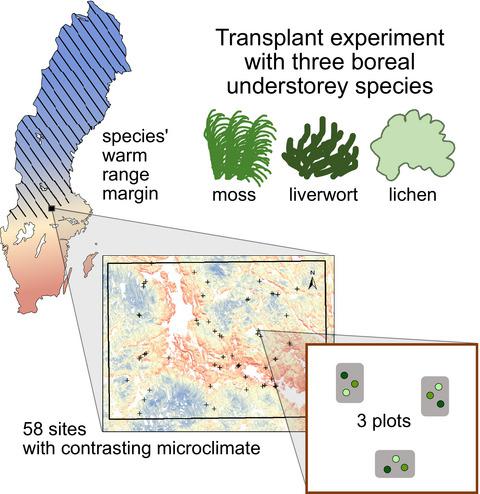Our official English website, www.x-mol.net, welcomes your
feedback! (Note: you will need to create a separate account there.)
Warm range margin of boreal bryophytes and lichens not directly limited by temperatures
Journal of Ecology ( IF 5.3 ) Pub Date : 2021-07-15 , DOI: 10.1111/1365-2745.13750 Caroline Greiser 1, 2 , Johan Ehrlén 1, 2 , Miska Luoto 3 , Eric Meineri 4 , Sonia Merinero 5 , Benny Willman 1 , Kristoffer Hylander 1, 2
中文翻译:

不受温度直接限制的北方苔藓植物和地衣的温差边缘
更新日期:2021-07-15
Journal of Ecology ( IF 5.3 ) Pub Date : 2021-07-15 , DOI: 10.1111/1365-2745.13750 Caroline Greiser 1, 2 , Johan Ehrlén 1, 2 , Miska Luoto 3 , Eric Meineri 4 , Sonia Merinero 5 , Benny Willman 1 , Kristoffer Hylander 1, 2
Affiliation

|
- Species at their warm range margin are potentially threatened by higher temperatures, but may persist in microrefugia. Whether such microsites occur due to more suitable microclimate or due to lower biotic pressure from, for example competitive species, is still not fully resolved.
- We examined whether boreal bryophytes and lichens show signs of direct climate limitation, that is whether they perform better in cold and/or humid microclimates at their warm range margin. We transplanted a moss, a liverwort and a lichen to 58 boreal forest sites with different microclimates at the species' southern range margin in central Sweden. Species were grown in garden soil patches to control the effects of competitive exclusion and soil quality. We followed the transplanted species over three growing seasons (2016–2018) and modelled growth and vitality for each species as a function of subcanopy temperature, soil moisture, air humidity and forest type. In 2018, we also recorded the cover of other plants having recolonized the garden soil patches and modelled this potential future competition with the same environmental variables plus litter.
- Species performance increased with warmer temperatures, which was often conditional on high soil moisture, and at sites with more conifers. Soil moisture had a positive effect, especially on the moss in the last year 2018, when the growing season was exceptionally hot and dry. The lichen was mostly affected by gastropod grazing. Recolonization of other plants was also faster at warmer and moister sites. The results indicate that competition, herbivory, shading leaf litter and water scarcity might be more important than the direct effects of temperature for performance at the species' warm range margin.
- Synthesis. In a transplant experiment with three boreal understorey species, we did not find signs of direct temperature limitation towards the south. Forest microrefugia, that is habitats where these species could persist regional warming, may instead be sites with fewer competitors and enemies, and with sufficient moisture and more conifers in the overstorey.
中文翻译:

不受温度直接限制的北方苔藓植物和地衣的温差边缘
- 处于温暖范围边缘的物种可能会受到更高温度的威胁,但可能会在微型避难所中持续存在。这些微型地点的出现是由于更合适的小气候还是由于来自例如竞争物种的较低生物压力,仍未完全解决。
- 我们检查了北方苔藓植物和地衣是否显示出直接气候限制的迹象,即它们是否在温暖范围边缘的寒冷和/或潮湿小气候中表现更好。我们将苔藓、地衣和地衣移植到瑞典中部该物种南部边缘的 58 个具有不同小气候的北方森林地点。物种在花园土壤斑块中生长,以控制竞争排斥和土壤质量的影响。我们在三个生长季节(2016-2018 年)跟踪移植的物种,并将每个物种的生长和活力建模为冠层温度、土壤湿度、空气湿度和森林类型的函数。2018 年,
- 物种表现随着温度升高而增加,这通常以高土壤湿度为条件,并且在针叶树较多的地方。土壤湿度产生了积极影响,尤其是在 2018 年最后一年的苔藓上,当时生长季节异常炎热和干燥。地衣主要受腹足动物放牧的影响。在温暖和潮湿的地方,其他植物的重新定植也更快。结果表明,竞争、食草、遮荫落叶和缺水可能比温度对物种温暖范围边缘性能的直接影响更重要。
- 合成。在对三种北方林下物种进行的移植实验中,我们没有发现向南直接限制温度的迹象。森林微型保护区,即这些物种可以持续区域变暖的栖息地,可能是竞争者和敌人较少的地方,并且有足够的水分和更多的针叶树在上层。











































 京公网安备 11010802027423号
京公网安备 11010802027423号